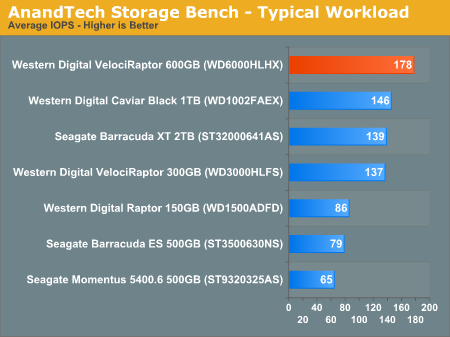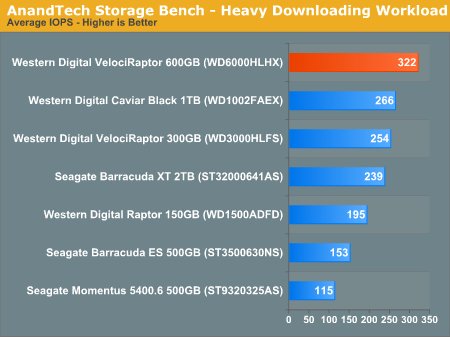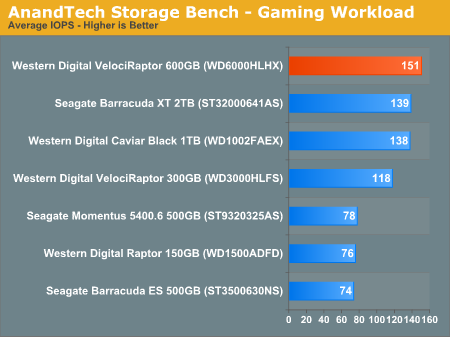Western Digital's New VelociRaptor VR200M: 10K RPM at 450GB and 600GB
by Anand Lal Shimpi on April 6, 2010 8:00 AM EST- Posted in
- Storage
AnandTech Storage Bench
The first in our benchmark suite is a light usage case. The Windows 7 system is loaded with Firefox, Office 2007 and Adobe Reader among other applications. With Firefox we browse web pages like Facebook, AnandTech, Digg and other sites. Outlook is also running and we use it to check emails, create and send a message with a PDF attachment. Adobe Reader is used to view some PDFs. Excel 2007 is used to create a spreadsheet, graphs and save the document. The same goes for Word 2007. We open and step through a presentation in PowerPoint 2007 received as an email attachment before saving it to the desktop. Finally we watch a bit of a Firefly episode in Windows Media Player 11.
There’s some level of multitasking going on here but it’s not unreasonable by any means. Generally the application tasks proceed linearly, with the exception of things like web browsing which may happen in between one of the other tasks.
The recording is played back on all of our drives here today. Remember that we’re isolating disk performance, all we’re doing is playing back every single disk access that happened in that ~5 minute period of usage. The light workload is composed of 37,501 reads and 20,268 writes. Over 30% of the IOs are 4KB, 11% are 16KB, 22% are 32KB and approximately 13% are 64KB in size. Less than 30% of the operations are absolutely sequential in nature. Average queue depth is 6.09 IOs.
The performance results are reported in average I/O Operations per Second (IOPS):

Performance in our real world benchmark however makes it very clear that no other hard drive is as fast as the 600GB VelociRaptor. WD delivers a nearly 30% improvement over the old drive, and 22% better performance than the new Caviar Black series.
If there’s a light usage case there’s bound to be a heavy one. In this test we have Microsoft Security Essentials running in the background with real time virus scanning enabled. We also perform a quick scan in the middle of the test. Firefox, Outlook, Excel, Word and Powerpoint are all used the same as they were in the light test. We add Photoshop CS4 to the mix, opening a bunch of 12MP images, editing them, then saving them as highly compressed JPGs for web publishing. Windows 7’s picture viewer is used to view a bunch of pictures on the hard drive. We use 7-zip to create and extract .7z archives. Downloading is also prominently featured in our heavy test; we download large files from the Internet during portions of the benchmark, as well as use uTorrent to grab a couple of torrents. Some of the applications in use are installed during the benchmark, Windows updates are also installed. Towards the end of the test we launch World of Warcraft, play for a few minutes, then delete the folder. This test also takes into account all of the disk accesses that happen while the OS is booting.
The benchmark is 22 minutes long and it consists of 128,895 read operations and 72,411 write operations. Roughly 44% of all IOs were sequential. Approximately 30% of all accesses were 4KB in size, 12% were 16KB in size, 14% were 32KB and 20% were 64KB. Average queue depth was 3.59.

Upping the number of writes doesn't change anything, the new VR is 26% faster than the old one and 21% faster than the best 7200 RPM drives. Keep in mind this is pure I/O performance, the real world performance is most likely in the 3 - 10% range on average which is what we saw in PCMark Vantage and SYSMark 2007.
The gaming workload is made up of 75,206 read operations and only 4,592 write operations. Only 20% of the accesses are 4KB in size, nearly 40% are 64KB and 20% are 32KB. A whopping 69% of the IOs are sequential, meaning this is predominantly a sequential read benchmark. The average queue depth is 7.76 IOs.

Sequential read performance is solid on the new VR, but not that much better than other, larger (and cheaper) drives on the market. Western Digital's advantage over the old VR is a healthy 27%, but over newer 7200 RPM drives it's barely 9%.










77 Comments
View All Comments
jasperjones - Tuesday, April 6, 2010 - link
I have the same question. How do you get 450GB capacity with a platter size of 200GB?By using three platters and rending some space on each platter unusuable??????
Anand Lal Shimpi - Tuesday, April 6, 2010 - link
Correct, you use 200GB platters and don't use all of the space. It's like microprocessor binning, but with platters instead :)Take care,
Anand
SunLord - Tuesday, April 6, 2010 - link
Hey Anand in theory wouldn't the 450GB drive be faster then a 600GB drive if they configured the firmware to not use the inner 50GB on each of the 3 platters?strikeback03 - Thursday, April 8, 2010 - link
Which would explain why there isn't much price difference between the 450 and 600GB models, but as you pointed out the price difference is so little as to be rather meaningless.Plus, with the combo of the 80GB X25-M and 1TB WD Black available for $10 more than the 600GB VR, the only consumer use for these I can see is if you are limited to a single drive with a tiny case or something.
Spivonious - Tuesday, April 6, 2010 - link
A 400% price increase for 10-15% performance increase? No thanks, I'll stick with my regular old 7200RPM drive.Chloiber - Tuesday, April 6, 2010 - link
These days, I don't see a reason why I should buy a Raptor. I get all my programs on an SSD, even some games. The rest of my data consinsts of music, movies and some archives. So basically I don't care about random read/write performance on these drives. Plus I need BIG drives. 1-2TB HDDs reach nearly the same sequential transfer rates as the raptors. Plus I dont wan't such noisy components in my system.If you only want 1 drive, then maybe the velociraptor is the way to go. But getting 1 drive is the worst decision one can make. I would rather get 2 crappy HDDs than 1 fast HDD.
As you wrote in the conclusion...performance wise, the raptors are really great, but these days, SSD + (cheap) HDD is the way to go imho.
vol7ron - Tuesday, April 6, 2010 - link
Agreed. SSDs replaced the need for Raptors, which makes me sad. Other than that, cheap, flexible storage is needed - as attributed by Moore's Law.rpsgc - Tuesday, April 6, 2010 - link
This review is useless without an SSD to compare to.vol7ron - Tuesday, April 6, 2010 - link
You're right, but as stated, go to the workbench and compare for those figures. You'll see that the SSDs would have drastically skewed the graphs.Voo - Tuesday, April 6, 2010 - link
Yeah but they could've been added to some of latter graphs without a problem (the AT bench for example), that would be inconsistent, but would give some nice overviews without clobbering the graphs too much.